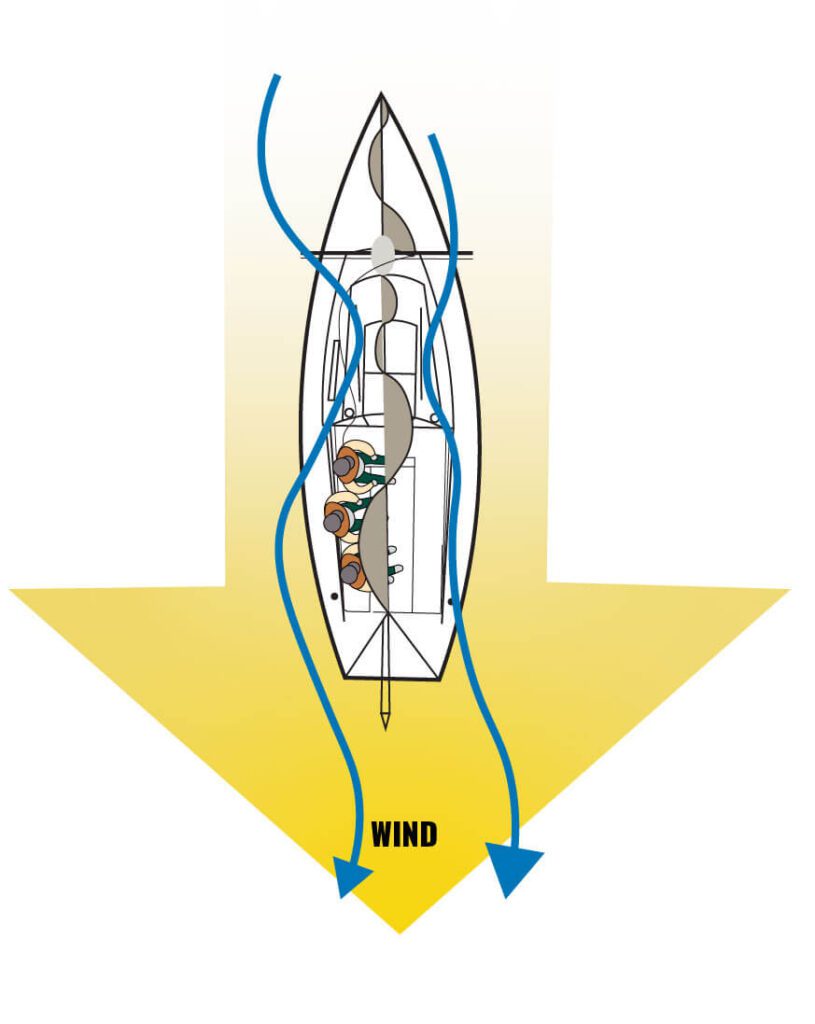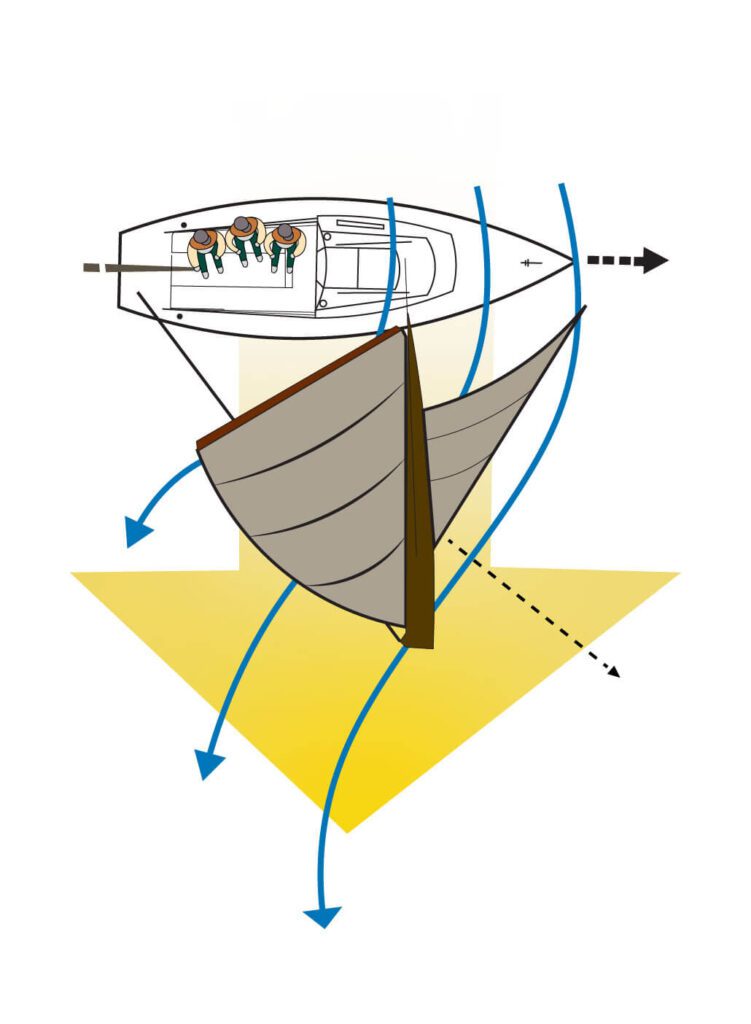One of the important things about learning to sail a boat is you need to understand what all the sailing terms mean. In particular, what does it mean when you are trying to sail into the wind?
When sailing into the wind, it is called the “No Go Zone” or sometimes the “No Sail Zone.” Some people may also refer to it as being “In irons.” All of these terms have the same meaning you cannot sail your boat into the wind because your sails cannot get a pull or push momentum to move your boat forward.
Table of Contents
- Sailing Into The Wind
- How To Know When You Are In The No-Go Zone For Sailing
- How Sailing Works – The Pull And Push Mode
- The Wind Push Mode For Sailing A Boat
- Related Questions
Sailing Into The Wind
When you sail into the wind, the term is known as the “No Sail Zone” or “No Go Zone,” or the terms “In Irons” can be used if you are trapped in the no go zone. These terms say that you are sailing right into the wind.
These terms are used because the boat will stop if you sail into the wind. In other words, the boat can not sail when pointed toward the wind.
Sailing Into the Wind means as follows:
- No Sail Zone – The term no sail zone means that if you sail your boat into the wind, your sails will not be able to catch any wind. There can be wind all around you, but your boat will not move forward as you are pointed into the wind. No wind can get into your sails to move your forward, so you are in the “No Sail Zone.”
- No-Go Zone – No-Go Zone is also used to show you sailing into the wind. The term is the same as the No Sail Zone and essentially means that a sailor needs to avoid going into the wind as you cannot sail into the wind.
The term “No Go Zone” is the term that the US Sailing Association uses. It is one of their points of sail on their point of sail charts.
Going Into the Wind Or “In Irons”
Sometimes you may also hear the term “In Irons” in sailing. The term” in irons” refers to the sailboat stuck in the “No Go Zone.” The ship cannot move or begin sailing in any direction, so it is stuck in irons.
The term “In Irons” comes from when the ships would haul criminals aboard the ships, and the criminals would be secured to the ship’s deck in leg irons so they could not move. When a ship is said to be “in irons,” they are also unable to move.
How To Know When You Are In The No-Go Zone For Sailing
When people start sailing, there is a good chance they will try to sail into the wind at some point. Like many other skills, sailing requires experience and an understanding of the wind.
A sailboat is not able to sail directly into the wind. If you were out sailing, you could try to sail into the wind, but you would not be able to go anywhere and could get stuck “in irons.” When you are in the No-Go Zone for sailing, your sails will luff, and you’ll be dead or stopped in the water.
To properly sell a boat, you need to have the wind in your sails in what is known as the pull or the push mode for your sails. In some instances, in the No-Go Zone, not only will you be stopped in the water, but if the wind is strong enough, you may find that your boat is starting to go backward.
The diagram below shows how your boat cannot sail in the No Go Zone or the No Sail Zone. As you go into the wind, the sails cannot get wind.

How Sailing Works – The Pull And Push Mode
When sailing, one of the most important things you need to know is what direction the wind is coming from. This is because sailboats are like boat engines, and it is a sail that produces the power to bring the boat forward.
It is also why your boat will not move when you are in the No-Go Zone or trying to sail directly into the wind. The sails cannot catch any wind; your sails need wind to drive the boat forward.
The Wind Pull Mode For Sailing A Boat
When your wind comes from the side of the boat, it will flow around both sides of the sails. This is similar to how an airplane can fly, as the wings create a lift. The same principle applies to sailing a boat in that the wind causes the boat to lift or pull the boat across the water using the wind.
The main principle in sailing is that you are catching the wind in such a direction that your sails can be filled with wind, and that wind will pull your boat forward.
When you are sailing, you will use the Push Mode a lot to move your boat as it is a very efficient way to sail your boat as the wind is coming along the sides of the boat.
The diagram below explains the basic principle of the Pull Mode for sailing a boat:

The Wind Push Mode For Sailing A Boat
When the wind comes behind you, the push mode is used for sailing a boat; this is when the wind will push your boat forward.
The key to this is the wind is coming from behind and not to the side of the boat. When the wind comes from behind, you also want to bring your sails out so they can catch as much wind as possible to propel or push you forward.
The diagram below shows when you are sailing in push mode.

Understanding what direction the wind comes from is essential in sailing; if you can understand what direction the wind is coming from, you can sail a boat.
At A Bus On A Dusty Road, we talk about everything about culture, travel, life, sailing, and ex-pat living. We are all about “Living Life As A Global Citizen.” We explore social, cultural, and economic issues and travel.
We would love to have you be part of our community. Sign up for our newsletter to keep up-to-date by clicking here. If you have any questions, you can contact me, Anita, by clicking here.
Listen to our Podcast called Dusty Roads. You can find it on all major podcast platforms. Try out listening to one of our podcasts by clicking here.
Subscribe to our A Bus On A Dusty Road YouTube Channel filled with great videos and information by clicking here.
Related Questions
What Is Jibing In Sailing? Steps To A Proper Controlled Jibe
A jibe in sailing is when the boat moves with the stern through the wind. In a jibe, the stern will move through the wind. Like any sailing maneuver, when you have a crew, the helmsman or the captain steering the boat needs to adequately communicate with the crew about what is happening so that they know; this is especially true when jibing.
By clicking here, you can discover What Is Jibing In Sailing? Steps To A Proper Controlled Jibe.
What Is Tacking In Sailing? Steps To A Proper Tack
Tacking is when you move the boat’s bow into the wind to turn the boat’s direction. It is a very common maneuver that all sailors must learn to master. But with any sailing maneuver, there are proper steps, you must learn to do a proper and safe tack.
By clicking here, you can discover What Is Tacking In Sailing? Steps To A Proper Tack
What Is The Sailing Term For “No Wind”?
The term calm or becalm is used to describe sailing with no wind. In ancient times, the sailors also used the word Tide Over to indicate that there was no wind, so they were Tide Over or stuck without being able to sail.
By clicking here, you can discover What Is The Sailing Term For “No Wind”?

